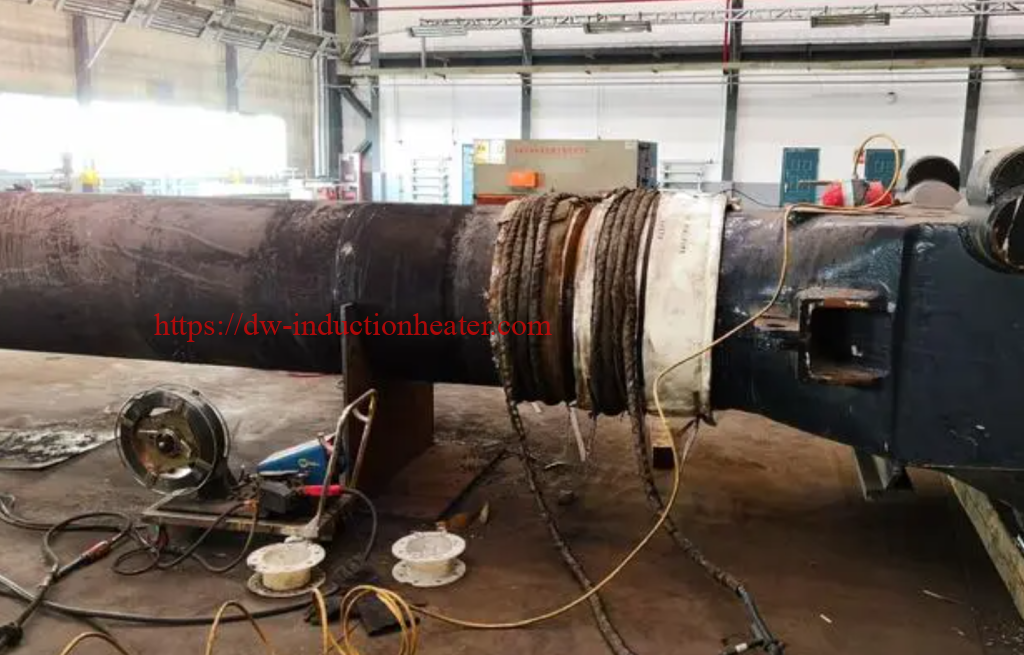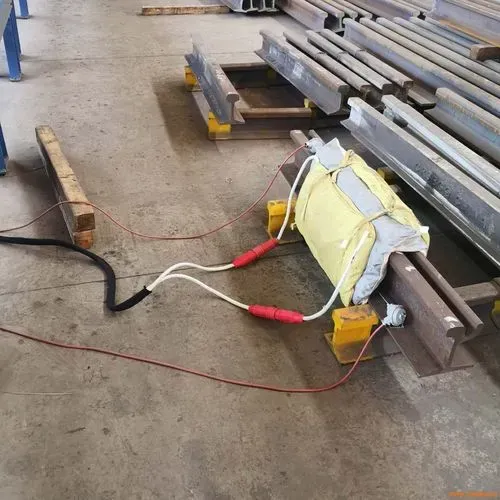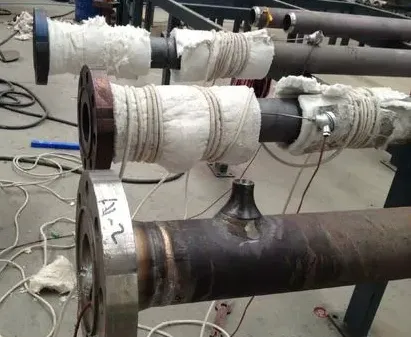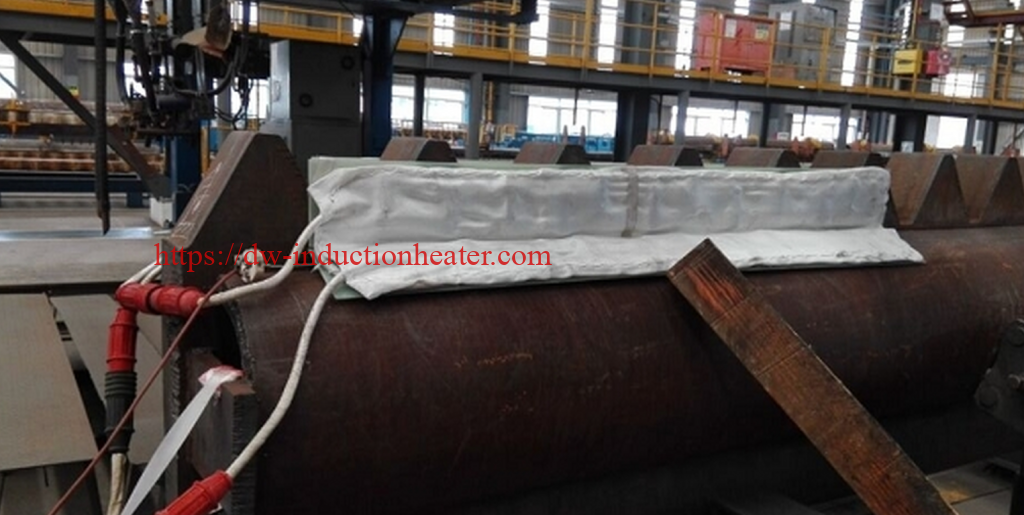
Why Induction Preheating is Essential for Welding: Benefits and Techniques.

Induction preheating is a process in which an electrically conductive material is heated by inducing an electrical current in it. The heat is produced by the resistance of the material to the current flow. Induction preheating is widely used in the welding industry for enhancing the quality of welds. This paper explores the benefits of induction preheating before welding, the process involved, and the effect it has on the welded joint.
Induction preheating offers numerous benefits, including:
 1. Stress Relief
1. Stress Relief
Induction preheating reduces the residual stress in the weld joint by expanding the base material before welding. As the material is heated, it expands, and when it cools, it contracts. This expansion and contraction reduce the residual stress in the weld joint, leading to a stronger and more durable joint.
2. Improved Weld Quality
Induction preheating helps to improve the quality of the weld by reducing the likelihood of porosity and cracking. The process reduces the amount of hydrogen in the weld pool, reducing the risk of porosity. Additionally, the heating process helps to improve the fusion of the weld, making it stronger and more durable.
3. Increased Efficiency
Induction preheating increases the efficiency of the welding process by improving the heat distribution in the workpiece. The process ensures that the heat is evenly distributed, reducing the welding time and improving the overall productivity.
Process of Induction Preheating before Welding
The process of induction preheating before welding involves the following steps:
1.How to choose the right induction heater for your welding project
While choosing an induction heater for your welding project, there are many factors to consider. First of all, you need to determine the size of the heater you require. This will depend on the size and thickness of the metal you are welding.

You should also make sure that the heater is compatible with the type of metal you are working with. Different metals have different melting points, so it's important to choose a heater that can handle the heat required. Additionally, you should consider the type of power source the heater requires, as well as the cost of operating it. Some induction heaters require a lot of power and can be expensive to run, so it's important to consider these factors before making a purchase. Finally, you should consider the brand and reputation of the manufacturer. You want to make sure that you are purchasing a high-quality heater that is built to last. By considering these factors, you can choose the right induction heater for your welding project and ensure that your project is a success.
2. Positioning the Workpiece
The next step is to position the workpiece correctly. The workpiece should be positioned so that the induction coil can be placed close to the welding area.
3. Applying the Induction Coil
The
induction coil is then applied to the workpiece, and a high-frequency AC current is passed through it. As the current passes through the workpiece, it heats it up, preheating it before welding.
4. Welding
Once the workpiece is preheated, the welding process can begin. The preheated material reduces heat input and welding time, which leads to a stronger and more durable joint.
Effect of Induction Preheating on the Welded Joint
Induction preheating has a significant effect on the welded joint. The preheating process reduces the residual stress in the joint and improves the quality of the weld. The modifications in the metal structure after preheating lead to reduced hardening in the heat-affected zone (HAZ). Overall, the preheating process leads to improved weld quality and durability.

Types of induction heaters for preheating
While the topic of becoming a better man is a broad one, it is important to focus on the transformative steps that can be taken to achieve this goal. One step that can be taken is to invest in high-quality tools that can help you in your journey. Induction heaters are one such tool that can be incredibly helpful, especially when it comes to preheating materials. There are several different types of induction heaters available, each of which has its own unique benefits. For example, some induction heaters are designed to be portable and easy to move around, while others are more stationary and designed to be used in a shop or garage setting. Similarly, some induction heaters are designed to be used with smaller materials, while others are more powerful and can be used with larger materials. When choosing an induction heater for preheating, it is important to consider your specific needs and choose a model that is designed to meet those needs. With the right tool in hand, you can take the first transformative step towards becoming a better man.
Conclusion
Induction preheating before welding is an essential process in the welding industry. The process has numerous benefits, including stress relief, improved welding quality, and increased efficiency. The process involves selecting the right equipment, positioning the workpiece, applying the induction coil, and welding. Induction preheating leads to a stronger and more durable joint and reduces the risk of porosity and cracking. Therefore, induction preheating is recommended for all welding applications.
 https://dw-inductionheater.com/why-induction-preheating-is-essential-for-welding.html?feed_id=206911&_unique_id=646afc635f31b
https://dw-inductionheater.com/why-induction-preheating-is-essential-for-welding.html?feed_id=206911&_unique_id=646afc635f31b

 Induction preheating is a process in which an electrically conductive material is heated by inducing an electrical current in it. The heat is produced by the resistance of the material to the current flow. Induction preheating is widely used in the welding industry for enhancing the quality of welds. This paper explores the benefits of induction preheating before welding, the process involved, and the effect it has on the welded joint.
Induction preheating is a process in which an electrically conductive material is heated by inducing an electrical current in it. The heat is produced by the resistance of the material to the current flow. Induction preheating is widely used in the welding industry for enhancing the quality of welds. This paper explores the benefits of induction preheating before welding, the process involved, and the effect it has on the welded joint.
 1. Stress Relief
Induction preheating reduces the residual stress in the weld joint by expanding the base material before welding. As the material is heated, it expands, and when it cools, it contracts. This expansion and contraction reduce the residual stress in the weld joint, leading to a stronger and more durable joint.
2. Improved Weld Quality
Induction preheating helps to improve the quality of the weld by reducing the likelihood of porosity and cracking. The process reduces the amount of hydrogen in the weld pool, reducing the risk of porosity. Additionally, the heating process helps to improve the fusion of the weld, making it stronger and more durable.
3. Increased Efficiency
Induction preheating increases the efficiency of the welding process by improving the heat distribution in the workpiece. The process ensures that the heat is evenly distributed, reducing the welding time and improving the overall productivity.
1. Stress Relief
Induction preheating reduces the residual stress in the weld joint by expanding the base material before welding. As the material is heated, it expands, and when it cools, it contracts. This expansion and contraction reduce the residual stress in the weld joint, leading to a stronger and more durable joint.
2. Improved Weld Quality
Induction preheating helps to improve the quality of the weld by reducing the likelihood of porosity and cracking. The process reduces the amount of hydrogen in the weld pool, reducing the risk of porosity. Additionally, the heating process helps to improve the fusion of the weld, making it stronger and more durable.
3. Increased Efficiency
Induction preheating increases the efficiency of the welding process by improving the heat distribution in the workpiece. The process ensures that the heat is evenly distributed, reducing the welding time and improving the overall productivity.
 You should also make sure that the heater is compatible with the type of metal you are working with. Different metals have different melting points, so it's important to choose a heater that can handle the heat required. Additionally, you should consider the type of power source the heater requires, as well as the cost of operating it. Some induction heaters require a lot of power and can be expensive to run, so it's important to consider these factors before making a purchase. Finally, you should consider the brand and reputation of the manufacturer. You want to make sure that you are purchasing a high-quality heater that is built to last. By considering these factors, you can choose the right induction heater for your welding project and ensure that your project is a success.
2. Positioning the Workpiece
The next step is to position the workpiece correctly. The workpiece should be positioned so that the induction coil can be placed close to the welding area.
3. Applying the Induction Coil
The induction coil is then applied to the workpiece, and a high-frequency AC current is passed through it. As the current passes through the workpiece, it heats it up, preheating it before welding.
4. Welding
Once the workpiece is preheated, the welding process can begin. The preheated material reduces heat input and welding time, which leads to a stronger and more durable joint.
You should also make sure that the heater is compatible with the type of metal you are working with. Different metals have different melting points, so it's important to choose a heater that can handle the heat required. Additionally, you should consider the type of power source the heater requires, as well as the cost of operating it. Some induction heaters require a lot of power and can be expensive to run, so it's important to consider these factors before making a purchase. Finally, you should consider the brand and reputation of the manufacturer. You want to make sure that you are purchasing a high-quality heater that is built to last. By considering these factors, you can choose the right induction heater for your welding project and ensure that your project is a success.
2. Positioning the Workpiece
The next step is to position the workpiece correctly. The workpiece should be positioned so that the induction coil can be placed close to the welding area.
3. Applying the Induction Coil
The induction coil is then applied to the workpiece, and a high-frequency AC current is passed through it. As the current passes through the workpiece, it heats it up, preheating it before welding.
4. Welding
Once the workpiece is preheated, the welding process can begin. The preheated material reduces heat input and welding time, which leads to a stronger and more durable joint.

 https://dw-inductionheater.com/why-induction-preheating-is-essential-for-welding.html?feed_id=206911&_unique_id=646afc635f31b
https://dw-inductionheater.com/why-induction-preheating-is-essential-for-welding.html?feed_id=206911&_unique_id=646afc635f31b
